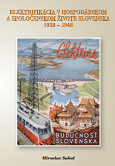Elektrifikácia v hospodárskom a spoločenskom živote Slovenska 1938 - 1948
Electrification in the Economic and Social Life of Slovakia 1938 - 1948
Author(s): Miroslav Sabol
Contributor(s): Eva Kratochvílová (Editor)
Subject(s): History, Economy, Energy and Environmental Studies, Economic history, Recent History (1900 till today), WW II and following years (1940 - 1949), Socio-Economic Research
Published by: SAV - Slovenská akadémia vied - Historický ústav SAV
Keywords: Slovakia; electrification; economy; economic development; 20th century;
Summary/Abstract: In the first half of the 20th century, the process of electrification was the background for economic development. In Slovakia, a breakthrough in the process of electrification began in 1918 after progressive large-area electrification. Between the two World Wars, the process went from local to a regional stage. Economic development in Slovakia in the following years 1938-1942 can be defined as a progressive transition from regional into a nationwide stage of electrification. In Slovakia, there were five state-owned power station companies working until 1942. Their main aim was the systemic electrification of areas given to them. Also, they had to harmonize an overall fragmentation of electrification process into one technical uniformity. That is why they had various legal and tax advantages than private power station companies. Slovakia, as the independent state set up in March 1939, had its economy under the influence of Nazi’s Germany economy, therefore it had to fulfil its interests. This influence changed the area of energetics as well. The first years after the new state was set up were unfavourable for the electrification process because of ill-judged personal changes, lack of finances as well as materials. Situation became more difficult when Slovakia ceded Hungary its South region on the basis of Vienna arbitrary decision. Power station companies lost their third of invested capital in already electrificated cities and municipalities which became a part of Hungary. In 1942, those five power station companies united into one company called Slovenské elektrárne. This company coordinated the large-area electrification in Slovakia. Number of electric energy consumers was constantly increasing due to consistent acquisition. Energy from water sources was used by hydroelectric power stations built across large Slovak rivers. Overall favourable development was interrupted by the passage of troops across Slovakia in 1944-1945. German troops destroyed lots of electrical utilities and paralyzed the electric supply. Damaged utilities were repaired during the first months after the war ended. In autumn 1945, all the power stations were nationalized in Slovakia. In 1946, Slovenské elektrárne and České elektrárne united into Československé energetické závody. A two-year plan for reconstruction of war-destroyed economy passed. Before the communist party entered in 1948, the number of electrificated cities and municipalities increased as well as the production and consumption of electric energy.
- Print-ISBN-13: 978-80-89396-07-8
- Page Count: 181
- Publication Year: 2010
- Language: Slovak
- eBook-PDF
- Sample-PDF
- Table of Content
- Introduction

